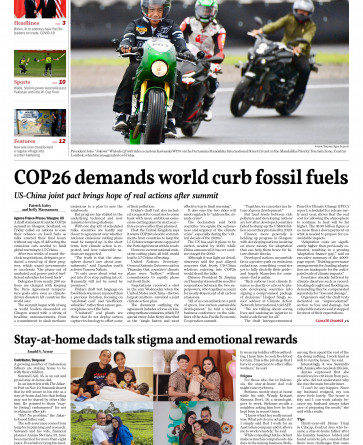ASEANEWS: HEADLINES-COP26: COP26 demands world curb fossil fuels
Indonesia signs COP26 coal phase-out pledge, lacks commitment
.
The Indonesian government recently signed the landmark coal phase-out pledge at the 26th United Nation Climate Change Conference (COP26). Despite being a step forward in obtaining international trust and financial support, the government’s reluctance to endorse one of the pledge’s four clauses shows a less than forthright stance toward a full withdrawal of coal-based power generation.
On the COP26 summit’s fourth day, Nov. 4, in Glasgow, Indonesia with over 40 countries signed another landmark pledge overseeing the coal phase-out. Under this new agreement, the country is seeking to retire 9.2 gigawatts (GW) of coal-fired power plants by 2030, which represents about a quarter of its total coal-based power generating capacity.1 This target is far more demanding than its initial plan to deactivate coal power by 1.1 GW by 2030.2
Nevertheless, it is noteworthy to point out that the government only “selectively” agreed to the pledge. In fact, it only endorsed the statement’s clause No. 1 (scaling up deployment of clean power generation), clause No. 2 (scaling up technologies and policies to move away from unabated coal power generation), and clause No. 4 (strengthening domestic and international efforts to support affected parties during the energy transition). The government refrained from endorsing the pledge’s clause No. 3 about stopping the issuance of permits for, and construction of, new unabated3 coal-fired power generation projects.4
In hindsight, the government’s move to embrace the ambitious initiative – although only partially – can be seen as an effort to gain more credibility and international trust, and therefore increase Indonesia’s opportunity to get financial support from developed countries to phase out coal and meet its Nationally Determined Contributions (NDCs) to reduce national emissions and adapt to the impacts of climate change.
Indonesia is far behind in securing international financial support, compared with South Africa, which secured commitment of US$8.5 billion worth of energy transition grants and concessionary loans from the United States, European Union and United Kingdom.5 Indonesia, in contrast, has merely secured a nonconcessionary financial leg up under the Energy Transition Mechanism (ETM) partnership program led by the Asian Development Bank (ADB).6 (See What’s more)
However, the country’s reluctance to stop incentivizing new coal-based power projects means its true commitment to phasing-out coal is rather vague. Clearly, the reluctance may stem from Indonesia’s large fleet of coal-fired plants already in the pipeline at around 13.8 GW—much higher than its abatement commitment of 9.2 GW—according to the latest electricity procurement plan (RUPTL).7 That and the soaring global price of coal (currently at around $160 per ton) together make it even more costly for Indonesia to be full-on in keeping its emission-reduction promise.
.

What’s more
ETM is a blended-finance initiative engineered by ADB in partnership with its developing member countries (DMCs) to accelerate the transition from fossil fuels to clean energy. It does so through two methods — the first consists of public and private investors financing country-specific ETM funds to retire coal power assets significantly sooner than if they remained with their current owners. The second mobilizes proceeds and margins from the retired assets toward renewable energy (RE) plants, including RE-relevant infrastructure such as grids and storage to generate clean energy.8
The scheme is reportedly backed by several private financial firms like Citibank, HSBC and Prudential, however their eventual participation remains unconfirmed.9 Unfortunately, despite it being promising at first, the ETM is still a cost-incurring financing option due to its privately sourced nature.
On the other hand, the country’s dire need for concessionary grants from developed countries does not appeal to President Joko “Jokowi” Widodo’s administration given its appetite to reap the most benefits coming from recent booms in the coal and mining sector.10 Such an attitude is largely triggered by huge opportunity costs resulting from high global demand for coal driven by economic recovery-related deficits in the largest coal-importing countries like China with its world’s largest pipeline of coal-based projects. As a result, coal prices have soared, which in early October 2021 jumped beyond US$200 per ton.
Also, the government seems to be bound to domestic interests. It has been adamant in resorting to coal gasification — a chemical process that turns solid coal into dimethyl ether (DME) which is expected to fully replace the liquefied petroleum gas (LPG) it currently imports until 2027.11 That suggests that the government’s preference for coal gasification is more carbon intensive than direct coal-burning.12

What we’ve heard
An entrepreneur who used to do business with PLN said it was currently seeking new sources of financing. The funds were needed to develop renewable energy projects to meet the nation’s carbon-neutrality commitments and to gradually phase out fossil fuel power plants.
PLN has experienced internal conflict over which coal-fired power plants (PLTU) to deactivate first once the contracts come due in 2058. One thing is clear, though: PLN must not issue new PLTU contracts after 2030. Although PLN is to develop renewable energy plants, the plan has been on-and-off as the company is still half-hearted about renewable energy.
The problem stems from a renewable energy bill that PLN believes favors private over state enterprises. This is despite the fact that renewable plants must be ready once fossil fuel power plants are shut down.
Indonesia needs $36.95 billion to sustain the development of renewable energy projects. Half of that figure must be covered by PLN. This is required to meet the renewable energy mix target by 2025, but in the thick of the pandemic, it has been difficult for PLN to find new financing while its own books suffer. Aside from seeking deals with domestic banks, it also plans to issue three fresh sets of bonds soon.

.

INDONESIA – COVID-19
Source: Indonesian government Last Update: Nov 12, 2021
.
























